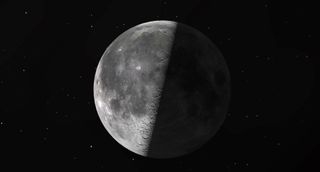See the last quarter moon of September 2022 tonight (Sept. 17)
The half-illuminated moon will rise before midnight and will disappear at dawn before setting at midday on Sunday.

On Saturday (Sept. 17) the moon will enter the stage of its phase called the last quarter — also called the third quarter — during which time it will be half-illuminated as seen from Earth.
Both the last quarter and the third quarter may be confusing names for this stage initially as the moon is half illuminated, but they actually refer to the fact that the moon has completed 3/4 of its orbit around Earth at this point.
The half-lit moon will be visible over New York at around 11:00 p.m. EDT (0300 GMT on Sept. 18) and it will disappear from view at the break of dawn on Sunday (Sept. 18) around 6:19 a.m. EDT (1019 GMT). At this time, the last quarter moon will reach an altitude of around 74 degrees above the horizon in the southeast (about seven fist widths at arm's length).
Related: Night sky, September 2022: What you can see tonight [maps]
During the lunar cycle, which takes around 29.5 days to complete, the moon is seen at different stages of illumination and at different times of the day.
At the last quarter, the moon rises around midnight and is at its maximum height above the horizon at around dawn. It sets around midday.
During the stage of the lunar cycle that includes the last quarter, the illumination of the moon is receding as its phase changes from the full moon to the new moon.
Get the Space.com Newsletter
Breaking space news, the latest updates on rocket launches, skywatching events and more!
Related: What is the moon phase today? Lunar phases 2022
The moon is said to be waning at this time as it changes from full moon — its most illuminated state — to its least illuminated stage, called the new moon. The moon's lighted side is shrinking because its orbit is taking it out of view from our perspective here on Earth.
The next stage in the moon's cycle after the last quarter is the waning crescent. At this point, the moon will be seen as little more than an arc of silver light as it is nearly back to the point in its orbit at which it directly faces the sun.

Looking for a telescope for the moon or lunar eclipse? We recommend the Celestron Astro Fi 102as the top pick in our best beginner's telescope guide.
Following this is the new moon, at which point the moon's illuminated side is fully facing the sun appearing near invisible from here on Earth. At this point, the moon rises and set with the sun, meaning it is out during the day. Following this, the lighted side of the moon grows and the moon begins to rise later each day — during which it is described as waxing — continuing until it is once again fully illuminated during the next full moon.
The divide between the light side and the dark side of the moon is called the 'lunar terminator' and during the last quarter, it marks sunset on the moon. On the flip side of this, during the first quarter, the lunar terminator shows sunrise on the moon.
During both the first and last quarters from above the moon's axis, the lunar terminator is aligned with the terminator line of Earth that divides night and day on our planet.
The next lunar cycle begins with the new moon on Sept. 25, with the next full moon on Oct. 9 and then the next last quarter moon rising on Oct. 17.
Be sure to check out our guides for the best binoculars and the best telescopes to spot the last quarter moon. For capturing the best moon pictures you can, check out our guide for photographing the moon, along with our recommendations for the best cameras for astrophotography and best lenses for astrophotography.
Editor's Note: If you snap a photo of the last quarter moon and would like to share it with Space.com's readers, send your photo(s), comments, and your name and location to spacephotos@space.com.
Follow us on Twitter @Spacedotcom or on Facebook.
Join our Space Forums to keep talking space on the latest missions, night sky and more! And if you have a news tip, correction or comment, let us know at: community@space.com.

Robert Lea is a science journalist in the U.K. whose articles have been published in Physics World, New Scientist, Astronomy Magazine, All About Space, Newsweek and ZME Science. He also writes about science communication for Elsevier and the European Journal of Physics. Rob holds a bachelor of science degree in physics and astronomy from the U.K.’s Open University. Follow him on Twitter @sciencef1rst.
